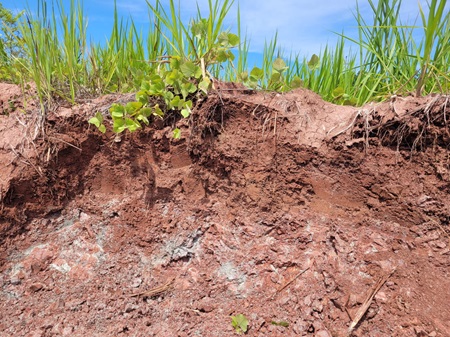Predicción de la fertilidad del suelo mediante aprendizaje automático en la provincia de Alto Amazonas, Perú
DOI:
https://doi.org/10.56926/repia.v3i2.63Palabras clave:
Random Forest, suelos amazónicos, modelamiento de suelos, suelos ácidosResumen
El objetivo del trabajo fue predecir la fertilidad del suelo en la provincia de Alto Amazonas con el uso de imágenes satelitales y técnicas de aprendizaje automático. El estudio se ubicó en la provincia de Alto Amazonas en Perú. Se realizaron muestreos de suelos en toda la provincia, totalizando 100 muestras. Posteriormente se realizaron análisis físicos (textura) y químicos del suelo. Las imágenes satelitales se obtuvieron del USGS y los índices de vegetación se calcularon con base en estas imágenes. Finalmente, se utilizó análisis descriptivo y modelado de aprendizaje automático utilizando 06 algoritmos (GLM, CUBIST, KKNN, SVM, Random Forest y NN) que se seleccionaron en función de su R2 y RMSE. En este trabajo observamos que la mayoría de los suelos de la provincia tienen bajos pH, P, Mg, K y alta acidez. También se lograron obtener buenas predicciones para pH, Ca, Mg y CIC y se observó que el algoritmo más exitoso fue Random Forest. Sin embargo, para Al, Cubist tuvo mejores resultados. Este es uno de los primeros trabajos que utiliza aprendizaje automático para predecir la fertilidad del suelo en la Amazonía peruana y se espera que pueda servir como base para futuros proyectos.
Descargas
Citas
Arévalo-Gardini, E., Canto, M., Alegre, J., Loli, O., Julca, A., & Baligar, V. (2015). Changes in soil physical and chemical properties in long term improved natural and traditional agroforestry management systems of cacao genotypes in Peruvian Amazon. PLoS ONE, 10(7). https://doi.org/10.1371/journal.pone.0132147 DOI: https://doi.org/10.1371/journal.pone.0132147
Bendig, J., Yu, K., Aasen, H., Bolten, A., Bennertz, S., Broscheit, J., Gnyp, M. L., & Bareth, G. (2015). Combining UAV-based plant height from crop surface models, visible, and near infrared vegetation indices for biomass monitoring in barley. International Journal of Applied Earth Observation and Geoinformation, 39, 79–87. https://doi.org/10.1016/j.jag.2015.02.012 DOI: https://doi.org/10.1016/j.jag.2015.02.012
Brus, D. J. (2019). Sampling for digital soil mapping: A tutorial supported by R scripts. Geoderma, 338, 464–480. https://doi.org/10.1016/J.GEODERMA.2018.07.036 DOI: https://doi.org/10.1016/j.geoderma.2018.07.036
Bünemann, E. K., Bongiorno, G., Bai, Z., Creamer, R. E., De Deyn, G., de Goede, R., Fleskens, L., Geissen, V., Kuyper, T. W., Mäder, P., Pulleman, M., Sukkel, W., van Groenigen, J. W., & Brussaard, L. (2018). Soil quality – A critical review. In Soil Biology and Biochemistry (Vol. 120, pp. 105–125). https://doi.org/10.1016/j.soilbio.2018.01.030 DOI: https://doi.org/10.1016/j.soilbio.2018.01.030
Canero, F. M., Rodriguez-Galiano, V., & Aragones, D. (2024). Machine Learning and Feature Selection for soil spectroscopy. An evaluation of Random Forest wrappers to predict soil organic matter, clay, and carbonates. Heliyon, 10(9). https://doi.org/10.1016/j.heliyon.2024.e30228 DOI: https://doi.org/10.1016/j.heliyon.2024.e30228
Campos, A. R., Giasson, E., Costa, J. J. F., Machado, I. R., Silva, E. B. da, & Bonfatti, B. R. (2019). Selection of Environmental Covariates for Classifier Training Applied in Digital Soil Mapping. Revista Brasileira de Ciência Do Solo, 42, e0170414. https://doi.org/10.1590/18069657RBCS20170414 DOI: https://doi.org/10.1590/18069657rbcs20170414
Chen, J. M. (1996). Evaluation of vegetation indices and a modified simple ratio for boreal applications. Canadian Journal of Remote Sensing, 22(3), 229–242. https://doi.org/10.1080/07038992.1996.10855178 DOI: https://doi.org/10.1080/07038992.1996.10855178
Chuvieco, E., Martín, M. P., & Palacios, A. (2002). Assessment of different spectral indices in the red-near-infrared spectral domain for burned land discrimination. International Journal of Remote Sensing, 23(23), 5103–5110. https://doi.org/10.1080/01431160210153129 DOI: https://doi.org/10.1080/01431160210153129
Dash, J., & Curran, P. J. (2007). Evaluation of the MERIS terrestrial chlorophyll index (MTCI). Advances in Space Research, 39(1), 100–104. https://doi.org/10.1016/j.asr.2006.02.034 DOI: https://doi.org/10.1016/j.asr.2006.02.034
Delgado-Caballero, C. E., Gómez-Guerrero, A., Valdez-Lazalde, J. R., De los Santos- Posadas, H., Fierros-González, A. M., & Horwath, W. R. (2009). Site index and soil properties in young plantations of Eucalyptus grandis and E. urophylla in southeastern México. Agrociencia, 43(1). https://www.agrociencia-colpos.org/index.php/agrociencia/article/view/697
Dharumarajan, S., Lalitha, M., Niranjana, K., & Hegde, R. (2022). Evaluation of digital soil mapping approach for predicting soil fertility parameters—a case study from Karnataka Plateau, India. Arabian Journal of Geosciences, 15(5), 1–21. https://doi.org/10.1007/S12517-022-09629-8 DOI: https://doi.org/10.1007/s12517-022-09629-8
Di Raimo, L. A. D. L., Couto, E. G., de Mello, D. C., Demattê, J. A. M., Amorim, R. S. S., Torres, G. N., Bocuti, E. D., Veloso, G. V., Poppiel, R. R., Francelino, M. R., & Fernandes-Filho, E. I. (2022). Characterizing and Modeling Tropical Sandy Soils through VisNIR-SWIR, MIR Spectroscopy, and X-ray Fluorescence. Remote Sensing 2022,14(19), 4823. https://doi.org/10.3390/RS14194823 DOI: https://doi.org/10.3390/rs14194823
EMBRAPA. (2009). Manual de análises químicas de solos, plantas e fertilizantes (2nd ed.). Embrapa. www.sct.embrapa.br/liv
Frampton, W. J., Dash, J., Watmough, G., & Milton, E. J. (2013). Evaluating the capabilities of Sentinel-2 for quantitative estimation of biophysical variables in vegetation. ISPRS Journal of Photogrammetry and Remote Sensing, 82, 83–92. https://doi.org/10.1016/j.isprsjprs.2013.04.007 DOI: https://doi.org/10.1016/j.isprsjprs.2013.04.007
Gamon, J. A., & Surfus, J. S. (1999). Assessing leaf pigment content and activity with a reflectometer. New Phytologist, 143(1), 105–117. https://doi.org/10.1046/j.1469-8137.1999.00424.x DOI: https://doi.org/10.1046/j.1469-8137.1999.00424.x
Gitelson, A. A., Gritz, Y., & Merzlyak, M. N. (2003). Relationships between leaf chlorophyll content and spectral reflectance and algorithms for non-destructive chlorophyll assessment in higher plant leaves. Journal of Plant Physiology, 160(3), 271–282. https://doi.org/10.1078/0176-1617-00887 DOI: https://doi.org/10.1078/0176-1617-00887
Gitelson, A. A., Merzlyak, M. N., & Chivkunova, O. B. (2001). Optical Properties and Nondestructive Estimation of Anthocyanin Content in Plant Leaves. Photochemistry and Photobiology, 74(1), 38–45. https://doi.org/10.1562/0031-8655(2001)0740038opaneo2.0.co2 DOI: https://doi.org/10.1562/0031-8655(2001)074<0038:OPANEO>2.0.CO;2
Hounkpatin, K. O. L., Bossa, A. Y., Yira, Y., Igue, M. A., & Sinsin, B. A. (2022). Assessment of the soil fertility status in Benin (West Africa) – Digital soil mapping using machine learning. Geoderma Regional, 28, e00444. https://doi.org/10.1016/J.GEODRS.2021.E00444 DOI: https://doi.org/10.1016/j.geodrs.2021.e00444
Huete, A. R. (1988). A soil-adjusted vegetation index (SAVI). Remote Sensing of Environment, 25(3), 295–309. https://doi.org/10.1016/0034-4257(88)90106-X INEI. (2012). IV Censo Nacional Agropecuario . In Resultados Definitivos. IV Censo Nacional Agropecuario. http://proyectos.inei.gob.pe/web/documentospublicos/resultadosfinalesivcenagro.pdf DOI: https://doi.org/10.1016/0034-4257(88)90106-X
Jordan, C. F. (1969). Derivation of Leaf-Area Index from Quality of Light on the Forest Floor. Ecology, 50(4), 663–666. https://doi.org/10.2307/1936256 DOI: https://doi.org/10.2307/1936256
Köppen, W. (1931). Grundriß der Klimakunde. In Grundriß der Klimakunde. De Gruyter. https://doi.org/10.1515/9783111667751 DOI: https://doi.org/10.1515/9783111667751
Lang, P., Qin, C. zhi, Zhu, A. xing, Hou, Z. wei, Fan, N. qing, & Wang, Y. jie. (2020). A case- based method of selecting covariates for digital soil mapping. Journal of Integrative Agriculture, 19(8), 2127–2136. https://doi.org/10.1016/S2095-3119(19)62857-1 DOI: https://doi.org/10.1016/S2095-3119(19)62857-1
Louhaichi, M., Borman, M. M., & Johnson, D. E. (2001). Spatially located platform and aerial photography for documentation of grazing impacts on wheat. Geocarto International, 16(1), 65–70. https://doi.org/10.1080/10106040108542184 DOI: https://doi.org/10.1080/10106040108542184
Lu, Q., Tian, S., & Wei, L. (2023). Digital mapping of soil pH and carbonates at the European scale using environmental variables and machine learning. Science of The Total Environment, 856, 159171. https://doi.org/10.1016/J.SCITOTENV.2022.159171 DOI: https://doi.org/10.1016/j.scitotenv.2022.159171
Lymburner, L., Beggs, P. J., & Jacobson, C. R. (2000). Estimation of canopy-average surface-specific leaf area using Landsat TM data. In Photogrammetric Engineering and Remote Sensing (Vol. 66, Issue 2, pp. 183–191).
Macedo Neto, A. A. L.; Farias, P. R. S.; Matos, G. S. B.; Silva, G. B.; Santos, A. V. F. Anhê, B. B. (2020). Diagnosis and spatial variability of soil fertility and crop production in a teak area in Eastern Pará State. CERNE, 26(1), 37-47. https://doi.org/10.1590/01047760202026012683 DOI: https://doi.org/10.1590/01047760202026012683
Mosaid, H., Barakat, A., John, K., Faouzi, E.H., Bustillo, V., El Garnaoui, M., & Heung, B. (2024). Improved soil carbon stock spatial prediction in a Mediterranean soil erosion site through robust machine learning techniques. Environmental monitoring and assessment, 196 2, 130. https://doi.org/10.1007/s10661-024-12294-x DOI: https://doi.org/10.1007/s10661-024-12294-x
Qi, J., Chehbouni, A., Huete, A. R., Kerr, Y. H., & Sorooshian, S. (1994). A modified soil adjusted vegetation index. Remote Sensing of Environment, 48(2), 119–126. https://doi.org/10.1016/0034-4257(94)90134-1 DOI: https://doi.org/10.1016/0034-4257(94)90134-1
R Core Team. (2021). R Core Team (2021). R: A language and environment for statistical computing. R Foundation for Statistical Computing, Vienna, Austria. URL Http://Www.R-Project.Org/
Richardson, A. J., & Wiegand, C. L. (1977). Distinguishing Vegetation from Soil Background Information. A gray mapping technique allows delineation of any Landsat scene into vegetative cover stages, degrees of soil brightness, and water. Photogrammetric Engineering and Remote Sensing, 43(13), 1541-1552. https://www.asprs.org/wp- content/uploads/pers/1977journal/dec/1977_dec_1541-1552.pdf
Rondeaux, G., Steven, M., & Baret, F. (1996). Optimization of soil-adjusted vegetation indices. Remote Sensing of Environment, 55(2), 95–107. https://doi.org/10.1016/0034-4257(95)00186-7 DOI: https://doi.org/10.1016/0034-4257(95)00186-7
Rouse, J. W., Haas, R. H., Schell, J. A., & Deering, D. W. (1974). Monitoring vegetation systems in the great plains with ERTS. NASA Goddard Space Flight Center 3d ERTS-1 Symposium, 1, 309–317. https://doi.org/10.1021/jf60203a024 DOI: https://doi.org/10.1021/jf60203a024
Roy, D. P., Boschetti, L., & Trigg, S. N. (2006). Remote sensing of fire severity: Assessing the performance of the normalized burn ratio. IEEE Geoscience and Remote Sensing Letters, 3(1), 112–116. https://doi.org/10.1109/LGRS.2005.858485 DOI: https://doi.org/10.1109/LGRS.2005.858485
Siqueira, R. G., Moquedace, C. M., Francelino, M. R., Schaefer, C. E. G. R., & Fernandes- Filho, E. I. (2023). Machine learning applied for Antarctic soil mapping: Spatial prediction of soil texture for Maritime Antarctica and Northern Antarctic Peninsula. Geoderma, 432, 116405. https://doi.org/10.1016/J.GEODERMA.2023.116405 DOI: https://doi.org/10.1016/j.geoderma.2023.116405
Sripada, R. P., Heiniger, R. W., White, J. G., & Meijer, A. D. (2006). Aerial color infrared photography for determining early in-season nitrogen requirements in corn. Agronomy Journal, 98(4), 968–977. https://doi.org/10.2134/agronj2005.0200 DOI: https://doi.org/10.2134/agronj2005.0200
Sujatha, M., & Jaidhar, C. D. (2023). Machine learning-based approaches to enhance the soil fertility—A review. Expert Systems with Applications, 240, 122557. https://doi.org/10.1016/j.eswa.2023.122557 DOI: https://doi.org/10.1016/j.eswa.2023.122557
Tucker, C. J. (1980). A spectral method for determining the percentage of green herbage material in clipped samples. Remote Sensing of Environment, 9(2), 175–181. https://doi.org/10.1016/0034-4257(80)90007-3 DOI: https://doi.org/10.1016/0034-4257(80)90007-3
Vescovo, L., & Gianelle, D. (2008). Using the MIR bands in vegetation indices for the estimation of grassland biophysical parameters from satellite remote sensing in the Alps region of Trentino (Italy). Advances in Space Research, 41(11), 1764–1772. https://doi.org/10.1016/j.asr.2007.07.043 DOI: https://doi.org/10.1016/j.asr.2007.07.043
Vieira, R. M. da S. P., Tomasella, J., Barbosa, A. A., Polizel, S. P., Ometto, J. P. H. B., Santos, F. C., Ferreira, Y. da C., & Toledo, P. M. de. (2021). Land degradation mapping in the MATOPIBA region (Brazil) using remote sensing data and decision-tree analysis. Science of The Total Environment, 782, 146900. https://doi.org/10.1016/J.SCITOTENV.2021.146900 DOI: https://doi.org/10.1016/j.scitotenv.2021.146900
Wadoux, A. M. J. C., Minasny, B., & McBratney, A. B. (2020). Machine learning for digital soil mapping: Applications, challenges and suggested solutions. Earth-Science Reviews, 210, 103359. https://doi.org/10.1016/J.EARSCIREV.2020.103359 DOI: https://doi.org/10.1016/j.earscirev.2020.103359
Wang, F., Huang, J., Tang, Y., & Wang, X. (2007). New Vegetation Index and Its Application in Estimating Leaf Area Index of Rice. Rice Science, 14(3), 195–203. https://doi.org/10.1016/s1672-6308(07)60027-4 DOI: https://doi.org/10.1016/S1672-6308(07)60027-4
Watt, M. S., Pearse, G. D., Dash, J. P., Melia, N., & Leonardo, E. M. C. (2019). Application of remote sensing technologies to identify impacts of nutritional deficiencies on forests. ISPRS Journal of Photogrammetry and Remote Sensing, 149, 226–241. https://doi.org/10.1016/j.isprsjprs.2019.01.009 DOI: https://doi.org/10.1016/j.isprsjprs.2019.01.009
Wu, W. (2014). The Generalized Difference Vegetation Index (GDVI) for dryland characterization. Remote Sensing, 6(2), 1211–1233. https://doi.org/10.3390/rs6021211 DOI: https://doi.org/10.3390/rs6021211
Yang, L., Li, X., Shi, J., Shen, F., Qi, F., Gao, B., & Chen, Z. (2020). Geoderma Evaluation of conditioned Latin hypercube sampling for soil mapping based on a machine learning method. Geoderma, 369, 114337. https://doi.org/10.1016/j.geoderma.2020.114337 DOI: https://doi.org/10.1016/j.geoderma.2020.114337

Publicado
Cómo citar
Número
Sección
Licencia
Derechos de autor 2024 César Oswaldo Arévalo-Hernández, Enrique Arévalo-Gardini, Luis Alberto Arévalo-López, Oscar Tuesta-Hidalgo, Dayani Shirley Romero-Vela, Claudia Elizabeth Ruiz-Camus

Esta obra está bajo una licencia internacional Creative Commons Atribución 4.0.
Los autores retienen sus derechos:
a. Los autores conservan los derechos de propiedad intelectual (copyright) de las obras publicadas, cediendole a la revista el derecho de primera publicación.
b. Los autores retienen sus derechos de marca y patente, y también sobre cualquier proceso o procedimiento descrito en el artículo.
c. Los autores retienen el derecho de compartir, copiar, distribuir, ejecutar y comunicar públicamente el artículo publicado en la REPIA (por ejemplo, colocarlo en un repositorio institucional o publicarlo en un libro), con un reconocimiento de su publicación inicial en la REPIA.
d. Los autores retienen el derecho a hacer una posterior publicación de su trabajo, de utilizar el artículo o cualquier parte de aquel (por ejemplo: una compilación de sus trabajos, notas para conferencias, tesis, o para un libro), siempre que indiquen la fuente de publicación (autores del trabajo, revista, volumen, número y fecha).







